There are some teams that can be said to have changed the course of football.
The great Hungary side of the 1950s, for example, changed the tactical landscape of the game by using players in different positional slots than most were used to. The Milan of the late 1980s and early 1990s introduced us to a more collective style, with their man-to-man defence balanced by an ability to attack as a single unit when in possession.
There are few teams, however, who can be said to have changed football twice in a relatively short space of time. Barcelona are one of those.
Firstly the Dream Team, coached by the great Johan Cruyff, married the Dutch principle of total football to the Spanish possession style.
One of the players that flourished under the leadership of Cruyff was Pep Guardiola, who played as the crucial single pivot at the base of the midfield. In 2008 Guardiola was appointed as the coach of Barcelona in his own right and he set about implementing a style of play that took concepts from Cruyff’s team and combined them with his own modern outlook on the game.
At the end of the 2010/11 season, Barcelona reached the final of the Champions League where they would face Manchester United. This match, more than any other, highlighted the impact that Guardiola had as the Spanish club won the match 3-1, but dominated to the extent that United barely saw the ball.
Indeed, after the match, United’s manager Sir Alex Ferguson was effusive in his praise stating that “No one has given us a hiding like that. It’s a great moment for them. They deserve it because they play the right way and enjoy their football”.
Let's provide some tactical context to the match and to show the key points that made Barcelona so dominant.
IMPORTANCE OF BREAKING THE LINES
Football never stands still - even now in a lockdown - and in the nine years since this match we have seen the tactical side of the game continue to develop and now the concepts that we saw in this match from Barcelona are relatively commonplace.
This has been further helped by the increase in interest in tactical analysis and writing amongst fans. Now, we often speak about players breaking the lines of the opposition, either through dribbling or passing. This is simply referring to the ball moving beyond a line of opposition defenders.
In 2011 there was still a lack of players who could play passes that broke the line of the opposition in central areas. It was more common for teams to attack in wide areas before then trying to play the ball into the middle.
Barcelona started to change all of that.
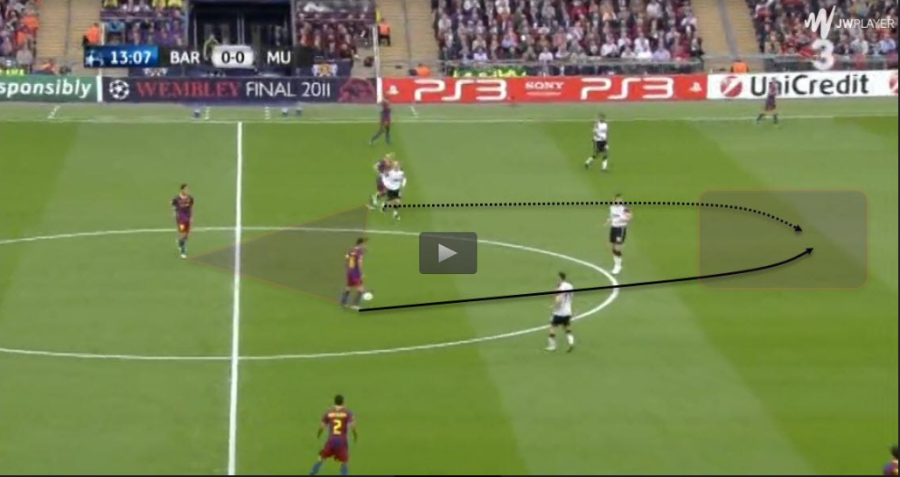
The midfield of this Barcelona side was, of course, world class. Sergio Busquets played as the single pivot at the base of the midfield three, in the position that Guardiola used to occupy. Ahead of him, we saw Andres Iniesta and Xavi combine.
The two advanced midfielders complemented one another perfectly with a mix of passing vision and the ability to drive forward in possession of the ball. With all three of the midfielders developed in the youth system of the club, there was a sense that each knew exactly what the other would do and where they would move to.
In the example above we see Xavi in possession of the ball and the United midfield slow to apply genuine pressure. Iniesta makes a run to break the line of the United midfield to reach the highlighted space. With Xavi’s composure in possession, he is able to wait for the run to be completed before the ball is then moved forward to find the run of Iniesta.
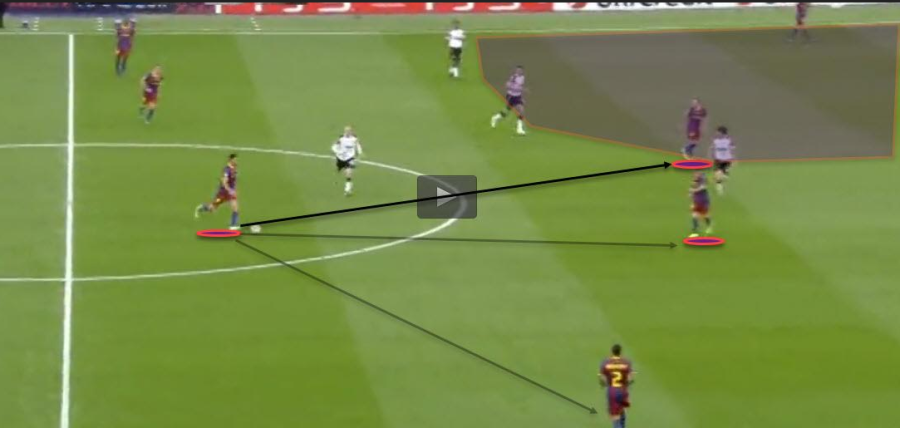
This time we see Busquets moving forward in possession of the ball while the United midfield line is slightly deeper. Once again the key is Iniesta as he takes up a high position, just on the blind side of the United midfielder, and the pass can be played into Iniesta’s feet in this position. In these areas, we would see Iniesta take possession and turn at the same time to drive into the highlighted space and threaten the United defensive line.
Throughout this match, we saw United struggle to come to terms with the movement and positioning of the Barcelona midfield as they took up space between the lines and passes the ball beyond the midfield time and time again.
ROTATIONS
We should make the point that this Manchester United team were by no means poor. They had already won the Premier League by 11 points from second-placed Chelsea, and were playing attractive, attacking football. With that said, their opponents here appeared to almost be playing a different sport.
Manchester United were used to facing teams that effectively played in straight lines. Players stay in their positional slots and the ball moves in familiar patterns. Barcelona, however, did not stick to any pattern that the United coaching staff would expect and instead the movement of both players and the ball made it very difficult to defend against effectively. A large part of this is down to the rotations of the players off the ball.
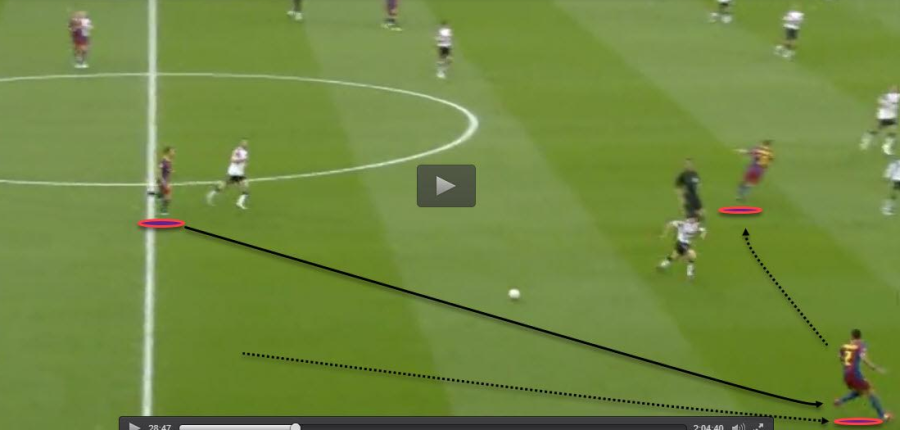
The rotations that we saw as Barcelona moved into the final third differed depending on the side of the pitch that the ball was on. Above we see an example of the kind of movements that we would see at Barca looked to advance down the right-hand side. Dani Alves, playing at right-back, was a player who was more comfortable in extremely high positions and whenever Barca were in possession he would immediately move forward.
This movement saw the right-sided attacker, either David Villa or Lionel Messi, move inside to create space. We see this above with the ball being played out to the right-hand side where Alves is moving forward to space. Villa has moved inside and these rotations force the United defenders to choose between tracking runs or holding their defensive shape. On the left side the movements were different with the left-sided attacker, Pedro, tending to remain wide and the left-back, Eric Abidal, taking up deeper positions in possession.
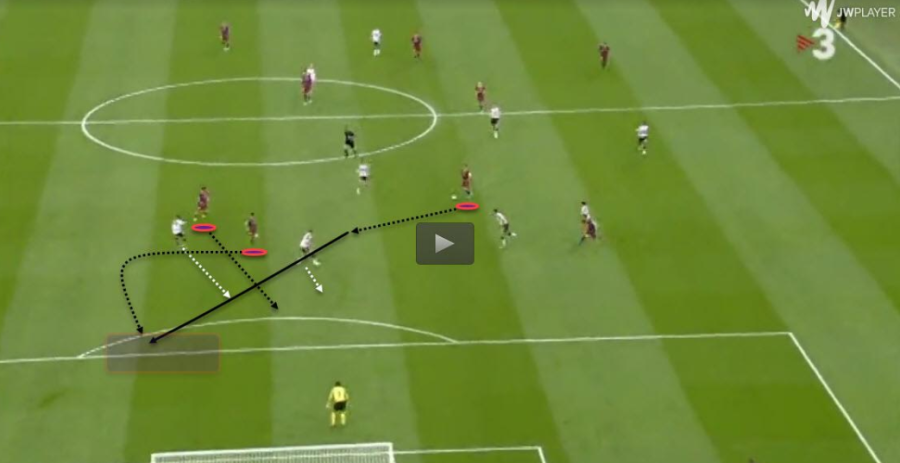
These rotations in the final third made it very difficult for the United defenders to track their man and defend effectively. This is a moment from the build-up to one of the Barcelona goals. With Xavi in possession, United struggle to put effective pressure on the ball. David Villa is the most advanced player and Messi is moving in support behind him.
Messi makes a sudden movement beyond the striker to threaten the space behind the defensive line and this causes the United defenders to crash back. Villa delays his movement and then curves his run to the far side of the penalty area. A simple pass from Xavi, who has again waited for the play to develop, allows Villa to take a touch before firing home. Once again rotations in terms of positions have created space and allowed Barcelona to easily play through the United defensive block.
MOVING DEFENDERS
The United defenders were constantly either dragged out of position or pinned and played past easily.
One of the biggest criticisms of this Barcelona team was that they were guilty of passing the ball just for the sake of passing it and in possession, you would often see the ball moving quickly over short distances even if there was no direct pressure from the opposition. Often times, however, people missed the point of these quick and short passes. They were designed to attract the opposition towards the ball and this would, in turn, create space elsewhere that could be exploited.
When these short passes were played forward into advanced positions they were designed to pin a defender in place before quickly shifting the focus of the attack and unbalancing the defending side. This is something at we saw often in this match as Barcelona pulled the United defensive block into areas that they wanted them in before quickly switching the angle and pace of the attack.
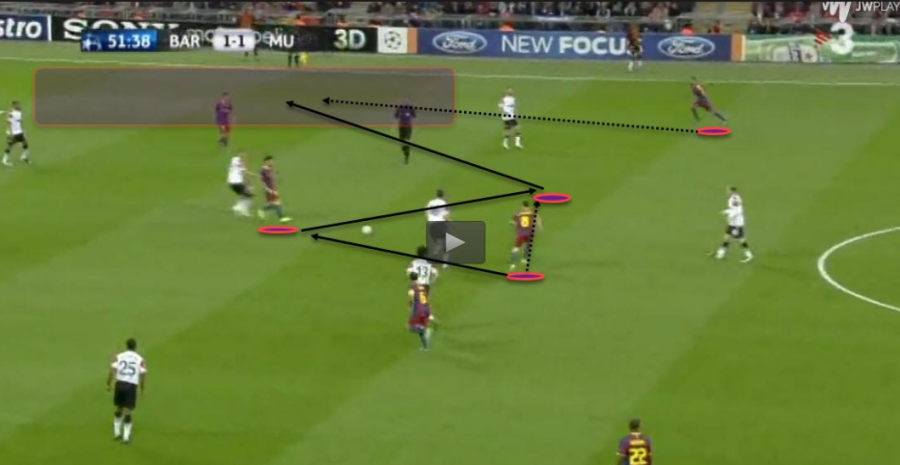
We see this here as Barcelona look to progress the ball forward. The first pass goes to the feet of Villa as he moves back towards the ball. This movement has dragged the United defender, Nemanja Vidic, towards the ball. Villa simply sets the ball back at a slightly different angle and as Iniesta moves across we see Alves moving quickly to a high position. Iniesta is then able to play a simple through ball to find this run.
You could argue that Iniesta could simply hold the ball and then wait for the run of Alves before releasing the pass. This, however, misses the point. The first pass, into Villa, is important because it pins Vidic and automatically makes the United defenders adjust towards the ball. The second pass, back to Iniesta, and the third pass, out to Dani Alves, are then executed quickly before United can properly adjust. This creates the space that Barcelona needed to play through the United block.
Conclusion
Arguably, this match was the pinnacle of the Barcelona of Guardiola. It provided the platform, the audience and the opposition that proved the effectiveness of the game model that had been build. The secret behind everything that Barcelona did from a tactical point of view revolved around the intelligence and the ability of the midfield, combined of course with the genius of Messi.
United were pulled all over the pitch and out-thought consistently. It is telling that this is a match that we can still learn so much from in terms of tactical concepts and execution.

 Lionel Messi
Lionel Messi  Pedro
Pedro  David Villa
David Villa  Man Utd
Man Utd 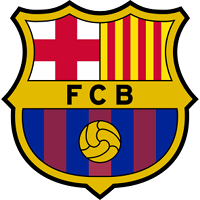 Barcelona
Barcelona 










